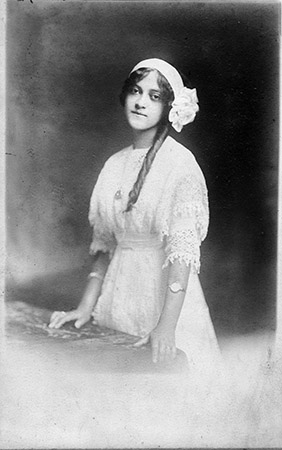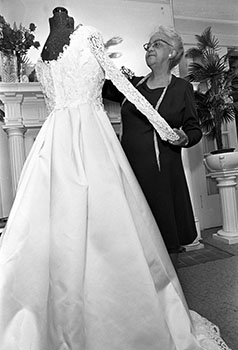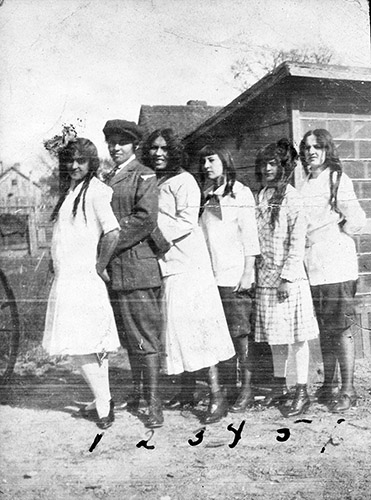17 Mar. 1894 – 25 Sept. 1992
“You have to like what you do, no matter what it is, to make a success of it.”
—Willie Otey Kay
Raleigh dressmaker, Willie Otey Kay, was born as Willie Virginia Otey to Henry Gaston Otey (1873-1937) and Josephine Alston Otey (1876-1924) on March 17, 1894. The Oteys married in 1893, and Willie was one of eight children who grew up in the family’s home on Cabarrus Street, within walking distance of Raleigh’s downtown. She first picked up sewing from her mother and grandmother and later became a dressmaker in Raleigh.
For more than 60 years she sewed elegant, dream-like gowns for girls and women, both black and white. Making beautiful, one-of-a-kind creations designed for the individuals who wore them earned Kay a reputation as the go-to designer for ladies’ formal wear in North Carolina and beyond.
A resident of Raleigh, Willie Kay died on September 29, 1992 at the age of 98 and was buried in the city’s New Hope Cemetery, established in 1872 for African Americans and today listed on the National Register of Historic Places. Her life and work were featured in numerous publications, including the News & Observer, and in 2016 an exhibit at the North Carolina Museum of History presented her life and legacy. That legacy included both her enduring creations as well her descendents' impact in the push for civil rights.
Life in Raleigh and Wilmington
Willie’s father Henry Otey, a prosperous African American businessman, owned a barbershop inside Fayetteville Street’s upscale Yarborough House hotel. At the Yarborough, Otey would have served exclusively white customers, especially politicians and well-to-do businessmen. The hotel was at various times home to North Carolina governors who lived there from the close of the Civil War to 1891 when the Executive Mansion was completed. The Yarborough was a place where many business and political discussions and governmental policy decisions took place, steps from the State Capitol.
The Otey family, with eight children, lived on Cabarrus Street, within walking distance of Hargett Street’s African American business district. The area took shape as black entrepreneurs organized together when racial segregation began to intensify around 1900. In the aftermath of the 1898 elections in which white supremacist Democrats took political and governmental control of the state and the ensuing violence in Wilmington the same year, the state succeeded in turning back years of progressive politics and reform. During that time, the General Assembly passed the state's first Jim Crow era legislation requiring separation of races in passenger trains and an amendment taking voting rights away from African Americans was added to the state constitution. The suffrage amendment effectively blocked black Republican political and social gains, ushering in a new era of discrimination and setting the stage for 20th century racial segregation. Some of Henry Otey's clients would have been among the men who succeeded in turning back the political and social clock. Willie Otey grew up in this social and political environment.

Willie Otey attended Shaw University. She majored in Home Economics, won first prize in the school’s dressmaking competition, and graduated in 1912. At Shaw she met her future husband, John Walcott Kay, a student at the university’s Leonard Medical School. Born in 1890 and from Weldon, North Carolina, John Kay had previously attended Kittrell College and matriculated at Shaw in 1908. Years later, some of the Kay children attended Shaw, and Willie Kay gave back to her alma mater as a successful businesswoman.
Willie Otey and John Kay married in 1915, and they moved to Wilmington where he pursued his medical career. In 1920 he co-founded, along with six other physicians and community members, a hospital for blacks – the Community Hospital. In Wilmington, the Kays had seven children, although only five survived infancy. They were married for 12 years when their life together came to a tragic end in 1927 when John Kay died from complications of an abdominal hernia. He had been aware of the developing condition but had ignored it, instead focusing on the care of his patients. He had surgery but did not recover and died on March 6, 1927.
Dressmaking: Art and Politics
Willie Kay returned to Raleigh with her children, ages 5 to 9, moved into her parents' house and took up dressmaking to support her young family. Overcoming despondence over her husband’s death and her unfortunate changed circumstances, she rediscovered her creative past. She decided to turn to a new identity as a seamstress and transformed her abilities into a successful and enduring business. She set up shop at home, where she could be present for her children during the day. Her sisters offered support, and her father spread word of her new enterprise through conversations with clients during haircuts and shaves. Wives and daughters of Henry Otey’s clients began to commission dresses, and Willie Kay embraced her new identity: Dressmaker.
Kay did not seek to create avant-garde fashion. Instead, she created figure-flattering formalwear that reflected the times. She designed what her clients wanted while tactfully guiding them toward sound choices. No one knew just how Willie Kay chose her clients, but she was in such demand that even the most prominent socialites worked around her schedule. Once granted an appointment, customers came to her home sewing room for consultations and measurements. Some knew exactly what they wanted. Others needed to look through the fashion magazines and drawings she kept handy. Despite her popularity, Kay never inflated her prices to retail rates. She charged only what she considered fair.

Those who knew Kay described her as soft-spoken, gentle, and refined — personality traits that contributed to her business success. She could calm a nervous debutante and satisfy a demanding bride while inspiring confidence in the mother footing the bill. And despite her clients’ prestige, they worked around Kay’s schedule. As many as 50 to 60 young women and their mothers would seek a coveted appointment each year to have a debutante gown made. Less than half would ultimately be chosen to receive a dress due to Kay’s busy schedule.
A cedar closet, built for Willie Kay by her son, John, shielded new dresses from customers’ curious eyes. When a woman came to see and try on her dress, Kay would remove it from the closet while carefully concealing other clients’ dresses. She practiced utmost discretion to ensure that designs remained secret until the wearer appeared in public. Kay often photographed customers modeling her finished designs, and many clients provided her with studio portraits of themselves in her dresses. She carefully preserved these images in the scrapbook she kept of her work.
Kay’s sisters were also accomplished dressmakers in their own right, and they contributed to the spread of the Otey name and its association with unique fine formalwear. Mildred Otey Taylor established her own dressmaking business, as did Chloe Otey Jervay Laws. Elizabeth Otey (Lizzie) Constant beaded expertly, and she embellished the dresses her sisters constructed. Josephine Otey Hayes lived in Atlantic City, New Jersey, but also sewed, specializing in children’s attire.
None of the Otey women used commercial patterns. Though Willie Otey Kay had studied sewing at Shaw University, she preferred the intuitive style of construction that her grandmother and mother had taught her and her sisters. Kay often began her custom designs with a sketch followed by a muslin or paper mock-up for fitting, and she preserved her sketches in an album. Then she cut fabric to fit her vision. She sculpted the cloth on her dress form and machine-stitched the seams on her sturdy Singer. In collaboration with her sister Lizzie, who did the beading, Kay finished detail work by hand.
Though fanciful lace appliqués and intricate beadwork were hallmarks of a Willie Kay gown, it was Kay’s sister Lizzie who created them. Elizabeth Otey Constant learned sewing along with her sisters, but she truly excelled at beadwork. She worked not only with Willie Otey Kay but also with Mildred Otey Taylor and Chloe Otey Jervay Laws to embellish the dresses they made. Throughout the week she visited her sisters’ houses, often with the assistance of her granddaughter, and spent hours adding delicate pearls, rhinestones, and lace appliqués to gowns.
Life during Segregation and the Civil Rights Era
In an era when most aspects of life in North Carolina were segregated for African Americans, Willie Kay designed for both black and white clients. During her most active periods, she made an equal number of dresses for the Alpha Kappa Alpha Ball (predominantly African American) and the North Carolina Debutante Ball (predominantly white) to ensure equity. Her sisters also designed for clients across racial boundaries. And although custom typically kept whites from visiting African Americans’ homes during the Jim Crow era, both white and black clients frequented Willie Kay’s home studio. And Kay also received tickets to attend to the black and white debutante balls in Raleigh.
Willie Kay became the mother and grandmother of civil rights advocates. Several of her children participated in social activism. Her daughter and son-in-law, June and Ralph Campbell, became prominent Raleigh civil rights activists in the 1960s and 1970s, and Ralph Campbell was president of the local chapter of the NAACP and the Raleigh-Wake Citizens Association. In 2005, June Campbell was honored for her courage and contribution to the civil rights movement by a resolution of the North Carolina General Assembly.
June Campbell was especially recognized for her courageous role integrating Raleigh public schools when she escorted her seven year old son Bill to school on September 7, 1960. That day Bill became the Murphey School's first black student, and the school became the city's first desegregated school. Willie Kay would also play a role, escorting Bill home from school in the afternoons. Bill Campbell later became mayor of Atlanta. Another of the Campbell's sons, Ralph, Jr., became the the first African American to hold elected executive office in North Carolina as State Auditor following four terms on the Raleigh City Council. Ralph Campbell passed away in 2011 at the age of 64.
Willie Kay's home became a safe haven for family when bomb threats made them unsafe in their own houses. And she used the proceeds of her business to strengthen Raleigh’s African American community. She was also a charter member of the Raleigh chapter of Links, a group of black women who raised money for education and charity. Kay remained active in the group throughout her life, as did her some of her sisters. She also patronized high-profile social functions like the Alpha Kappa Alpha Debutante Ball, Blue Revue, and Jabberwock.

Saint Ambrose Episcopal Church
Throughout her life, Willie Kay found a spiritual home at Saint Ambrose Episcopal Church in Raleigh. The congregation was an extension of her family, and her family made up a significant proportion of the membership. She was confirmed there, married there, and participated as an active member for decades. Saint Ambrose’s congregation formed in 1868, shortly after the end of slavery. The original wood frame building was built in 1879 on Lane Street. In 1900 it was moved to the corner of Cabarrus and Wilmington. The congregation moved again in 1965 to a new building in the Rochester Heights neighborhood.
The Otey sisters made vestments for Saint Ambrose, likely to celebrate the new church building, which opened in 1965. After Willie Otey Kay’s death, her children dedicated a stained-glass window to her memory.
Sewing a legacy in Raleigh and beyond
From governors’ wives to prominent socialites, Willie Kay’s clientele included a who’s who of North Carolina society. Customers sometimes brought Kay expensive fabric they had purchased abroad to have dresses made. One woman bought a gown in Europe, brought it to Kay to copy, and then returned the original dress overseas.
Many women so valued their Willie Kay dresses that they planned to use them more than once. Kay commonly altered debutante dresses into wedding gowns. Some families passed down Kay dresses for use at multiple functions by several generations of women.
Willie Kay received widespread acclaim during her lifetime. McCall’s magazine did a story on her work in 1935, and in 1951 Life magazine featured one of Kay’s debutante gowns on its cover. Local publications also highlighted her creations, and the publicity led to even more recognition and renown. Despite her growing status, Kay maintained her signature humility. She carried on her business for nearly six decades, sending all five of her children to college with the proceeds, and sewing well into her 90s.
Children of Josephine and Henry Otey:
Willie Virginia Otey Kay (1894-1992)
Elizabeth Louise Otey Constant (1895–1990)
Mildred McKee Otey Taylor (1897–1990)
Inez Henry Otey (1898–1917)
Charles King Otey (1900–1945)
Josephine Otey Hayes (1901–1972)
Chloe Otey Jervay Laws (1904–1997)
Henry Gaston Otey Jr. (1905–1942)
Children of Willie Otey and John Kay:
Josephine Jessie Kay (1916–1918)
Inez Otey Kay White (1918–1986)
Gloria Clementine Kay Greene (1919–2014)
Willie Virginia Kay (1921–1922)
Constance Taylor Kay Journigan Wilcox (1922–1981)
John Walcott Kay II (1923–1990)
June Elizabeth Kay Campbell (1925–2004)
Oral history recordings about Willie Kay
In 2016, the North Carolina Museum of History presented an exhibit on Willie Kay, her life and her dressmaking. Ten oral histories from people who knew her or who owned one of her creations were included in the exhibit. Listen to them here.